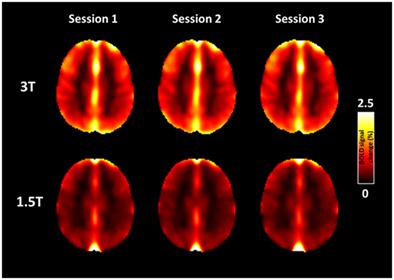当前位置:
X-MOL 学术
›
NMR Biomed.
›
论文详情
Our official English website, www.x-mol.net, welcomes your
feedback! (Note: you will need to create a separate account there.)
Short- and long-term reproducibility of BOLD signal change induced by breath-holding at 1.5 and 3 T.
NMR in Biomedicine ( IF 2.7 ) Pub Date : 2019-12-29 , DOI: 10.1002/nbm.4195 Shin-Lei Peng,Hui-Chieh Yang,Chun-Ming Chen,Cheng-Ting Shih
NMR in Biomedicine ( IF 2.7 ) Pub Date : 2019-12-29 , DOI: 10.1002/nbm.4195 Shin-Lei Peng,Hui-Chieh Yang,Chun-Ming Chen,Cheng-Ting Shih

|
Cerebrovascular reactivity (CVR) can give insight into the cerebrovascular function. CVR can be estimated by measuring a blood-oxygen-level-dependent (BOLD) response combined with breath-holding (BH). The reproducibility of this technique has been addressed and existing studies have focused on short-term reproducibility using a 3 T magnetic resonance imaging (MRI) system. However, little is known about the long-term reproducibility of this procedure and the corresponding reproducibility using a 1.5 T MRI system. Here, we systematically examined the short- and long-term reproducibility of BOLD responses to BH across field strengths. Nine subjects participated in three MRI sessions separated by 30 minutes (sessions 1 and 2: short term) and 68-92 days (sessions 1 and 3, long term) at both 1.5 and 3 T MRI. Our findings revealed that significant differences between field strengths were detected in the activated gray matter volume and BOLD signal change (both P < 0.001), with smaller magnitudes at 1.5 T. However, activation patterns were reproducible, independent of the time interval, brain region or field strength. All interscan coefficient of variation values were below the 33% fiducial limit, and the intraclass correlation coefficient values were above 0.4, which is usually considered the acceptability limit in functional studies. These findings suggest that the response of BOLD signal to BH for assessing CVR is reproducible over time at 1.5 and 3 T. This technique can be considered a tool for monitoring longitudinal changes in patients with cerebrovascular diseases, and its use should be encouraged for clinical 1.5 T MRI systems.
中文翻译:

在1.5和3 T屏住呼吸引起的BOLD信号变化的短期和长期可重复性。
脑血管反应性(CVR)可以深入了解脑血管功能。可以通过测量血氧水平依赖性(BOLD)反应与屏气(BH)相结合来估算CVR。该技术的可重复性已得到解决,现有研究集中在使用3 T磁共振成像(MRI)系统的短期可重复性上。但是,对该程序的长期可重复性以及使用1.5 T MRI系统的相应可重复性知之甚少。在这里,我们系统地研究了跨场强对BH的BOLD反应的短期和长期可重复性。九名受试者参加了三个MRI会议,分别在1.5和3 T MRI时相隔30分钟(会议1和2:短期)和68-92天(会议1和3,长期)。我们的发现表明,在激活的灰质体积和BOLD信号变化(均P <0.001)中检测到场强之间存在显着差异,在1.5 T时幅度较小。但是,激活模式是可重现的,与时间间隔,大脑区域无关或场强。所有扫描间变异系数值均低于33%基准限值,而组内相关系数值均高于0.4,这在功能研究中通常被认为是可接受的限值。这些发现表明,在1.5和3 T时,BOLD信号对BH评估CVR的反应在一段时间内可重现。该技术可被视为监测脑血管疾病患者纵向变化的工具,在临床1.5中应鼓励使用该技术。 T MRI系统。
更新日期:2020-02-04
中文翻译:

在1.5和3 T屏住呼吸引起的BOLD信号变化的短期和长期可重复性。
脑血管反应性(CVR)可以深入了解脑血管功能。可以通过测量血氧水平依赖性(BOLD)反应与屏气(BH)相结合来估算CVR。该技术的可重复性已得到解决,现有研究集中在使用3 T磁共振成像(MRI)系统的短期可重复性上。但是,对该程序的长期可重复性以及使用1.5 T MRI系统的相应可重复性知之甚少。在这里,我们系统地研究了跨场强对BH的BOLD反应的短期和长期可重复性。九名受试者参加了三个MRI会议,分别在1.5和3 T MRI时相隔30分钟(会议1和2:短期)和68-92天(会议1和3,长期)。我们的发现表明,在激活的灰质体积和BOLD信号变化(均P <0.001)中检测到场强之间存在显着差异,在1.5 T时幅度较小。但是,激活模式是可重现的,与时间间隔,大脑区域无关或场强。所有扫描间变异系数值均低于33%基准限值,而组内相关系数值均高于0.4,这在功能研究中通常被认为是可接受的限值。这些发现表明,在1.5和3 T时,BOLD信号对BH评估CVR的反应在一段时间内可重现。该技术可被视为监测脑血管疾病患者纵向变化的工具,在临床1.5中应鼓励使用该技术。 T MRI系统。











































 京公网安备 11010802027423号
京公网安备 11010802027423号